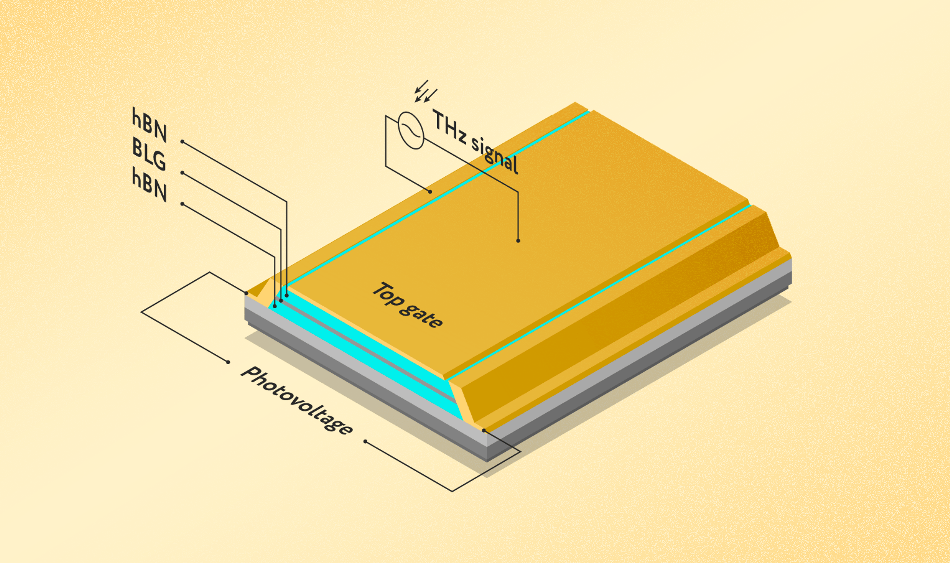Dec 24 2018
An international group of researchers from Japan, Russia, Italy, and Great Britain has developed a novel graphene-based terahertz detector. The results of the study have been reported in Nature Communications.
 Detector layout. The transistor channel, made of bilayer graphene (BLG), is sandwiched between two crystals of hexagonal boron nitride (hBN). This structure is placed on an oxidized silicon substrate (shown in gray). The two sleeves of a terahertz antenna are connected between the source and the top gate—that is, the left and top electrodes shown in gold. Signal voltage is read between the source and the drain terminals—the right and left electrodes. (Image credit: @tsarcyanide/MIPT Press Office)
Detector layout. The transistor channel, made of bilayer graphene (BLG), is sandwiched between two crystals of hexagonal boron nitride (hBN). This structure is placed on an oxidized silicon substrate (shown in gray). The two sleeves of a terahertz antenna are connected between the source and the top gate—that is, the left and top electrodes shown in gold. Signal voltage is read between the source and the drain terminals—the right and left electrodes. (Image credit: @tsarcyanide/MIPT Press Office)
Any kind of system meant for wireless data transfer normally depends on electromagnetic wave detectors and sources; however, they are not available for all kinds of waves. The existing terahertz radiation sources either need strong cooling or consume significant amounts of power. Terahertz radiation typically occupies a central ground between infrared light and microwaves. However, T-waves can possibly enable studies of space objects through radio telescopes, allow faster Wi-Fi, and facilitate innovative techniques of medical diagnostics.
The existing terahertz detectors are inefficient because of the mismatch between the size of the transistor, which is the detecting element measuring roughly one-millionth of a meter, and the standard wavelength of terahertz radiation, which is about 100 times greater. This causes the wave to slip past the detector with no interaction.
In the year 1996, it was suggested that this problem could possibly be resolved by compressing the energy of an incident wave into a volume similar to the detector’s size. Hence, for this purpose, the detector material must be able to support “compact waves” of a unique kind, known as plasmons. They denote the combined movement of conduction electrons and the related electromagnetic field, similar to the surface sea waves that move along with the wind when a storm sets in. Theoretically, under wave resonance, the efficiency of such a detector is increased further.
However, contrary to the expectations, it proved rather difficult to implement such a detector. In the majority of semiconductor materials, rapid damping is experienced by plasmons—in other words, they die down—because of electron collisions with impurities. Graphene was viewed as a potential alternative; however, this too was not sufficiently clean until recently.
The study authors presented a solution for the ubiquitous issue related to the detection of resonant T-waves. They eventually developed a photodetector composed of bilayer graphene encapsulated amid boron nitride crystals and attached to a terahertz antenna. In this sandwich arrangement, impurities are forced to the outside of the graphene flake, allowing the plasmons to propagate in a free manner. Limited by metal leads, the graphene sheet forms a plasmon resonator and the graphene’s bilayer structure makes it possible to tune the wave velocity in a broad range.
In effect, the physicists have created a compact terahertz spectrometer that measures only several microns in size and its resonant frequency is regulated through voltage tuning. The team has also demonstrated that the detector can possibly be used in important studies: By determining the detector’s current at numerous electron densities and frequencies, the properties of plasmons can be exposed.
Our device doubles up as a sensitive detector and a spectrometer operating in the terahertz range, and it’s also a tool for studying plasmons in two-dimensional materials. All of these things existed before, but they took up a whole optical table. We packed the same functionality into a dozen micrometers.
Dmitry Svintsov, Study Co-Author and Head, Laboratory of 2D Materials for Optoelectronics, Moscow Institute of Physics.
Source: https://mipt.ru/english